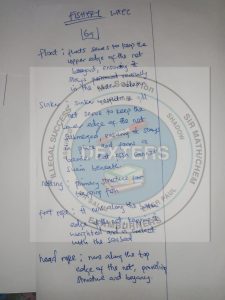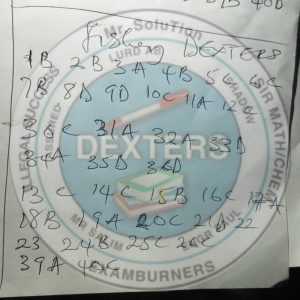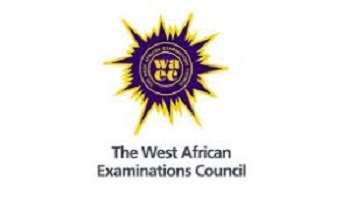Fishery Waec Answers 2024
*NUMBER 6*
(6a)
(i) Float: Keeps the top of the net buoyant, preventing it from sinking.
(ii) Sinker: Helps the net sink to the desired depth underwater.
(iii) Netting: Forms the main body of the net, capturing fish as they swim into it.
(iv) Float rope: Attaches the floats to the top of the net, aiding in keeping it afloat and visible.
(v) Head rope: Secures the top of the net and provides stability during deployment and retrieval.
(6b)
(I) Trawler
(ii) Longliner
(iii) Purse seiner
(iv) Gillnetter
(v) Drift netter
(6c) Making a fish pond involves several steps. Firstly, select a suitable site with access to water and good drainage. Excavate the area to the desired shape and depth, ensuring proper water circulation. Line the pond with a waterproof material like clay or synthetic liners to prevent water seepage. Fill the pond with water and stock it with fish species suited to the environment. Lastly, manage the pond by monitoring water quality, feeding the fish, and controlling pests and predators.
(6d)
(ii) Aeration systems: Such as aerators or air diffusers to maintain oxygen levels in the water.
(ii) Pond liners: To prevent water seepage and maintain water levels.
(iii) Fish feed: Pellets or formulated feed to provide proper nutrition to the fish.
(iv) Nets and traps: For harvesting fish or controlling unwanted species within the pond.
(1a)
(i) Fishing Gear: Tools for fishing like rods, nets, and lures.
(ii) Fishing Craft: Boats used for fishing activities.
(1b)
(i) Partial Harvesting: This involves selectively harvesting mature fish from the pond while leaving some behind to continue growing. It allows for continuous production over time.
(ii) Complete Harvesting: In this method, all the fish in the pond are harvested at once. After harvesting, the pond is usually drained, cleaned, and restocked with new fish.
(1c)
(i) Select Broodstock: Pick healthy, mature fish.
(ii) Administer Hormones: Stimulate spawning.
(iii) Collect Eggs and Sperm: From selected fish.
(iv) Fertilize Eggs: Combine eggs and sperm.
(v) Incubate: Hatch eggs in controlled conditions.
(vi) Manage Hatchery: Care for larvae until mature.
(1d)
(i) Appearance: Males and females look different.
(ii) Reproductive Organs: Females have ovaries, males have testes.
(iii) Secondary Traits: Males may have distinct markings or features during breeding.

(5b) Differences between finalhand sported/fast based on the following parts:
(i) Gills: Finalhand fish have gills covered with a bony plate, while fast fish have gills without a bony plate.
(ii) Skin: Finalhand fish have smooth and slimy skin, while fast fish have rough and scaly skin.
(iii) Muscle: The muscle structure of finalhand fish is generally more delicate compared to fast fish due to their sedentary lifestyle.
(iv) Eyes: Finalhand fish have relatively smaller eyes compared to fast fish, which have larger and more prominent eyes for hunting and evading predators.
(v) Belly: The belly of finalhand fish is often lighter in color and less muscular compared to the belly of fast fish, which is usually darker and more muscular.
(5c) Ways of preventing fish spoilage:
1. Proper refrigeration or storage at low temperatures to slow down bacterial growth and enzymatic reactions.
2. Use of ice or cooling packs during transportation and storage to maintain the freshness of the fish.
3. Vacuum sealing or packaging in airtight containers to prevent exposure to air and reduce oxidation.
4. Adding preservatives such as salt or vinegar to inhibit bacterial growth.
5. Quick and efficient gutting and cleaning of the fish after catching to remove potential sources of contamination.
6. Utilizing proper sanitation and hygiene practices during handling and processing to minimize the risk of contamination.
(5d) By-catch in fisheries refers to the incidental capture of non-target species, such as marine mammals, sea turtles, seabirds, and other fish species, during fishing operations targeting a specific species. This unintentional catch often results in the injury or mortality of the by-catch species and can have significant ecological and conservation implications.
6. (a) Functions of the following parts of a gill net:
(i) Float: The float keeps the top of the net buoyant and prevents it from sinking, allowing the net to remain at the desired depth in the water.
(ii) Sinker: The sinker provides weight to the bottom of the net, ensuring that it remains vertically oriented in the water column and effectively captures fish.
(iii) Netting: The netting forms the mesh structure of the gill net, allowing water to pass through while entrapping fish by their gills as they attempt to swim through the net.
(6a)
(i) Float: Keeps the top of the net buoyant, preventing it from sinking.
(ii) Sinker: Helps the net sink to the desired depth underwater.
(iii) Netting: Forms the main body of the net, capturing fish as they swim into it.
(iv) Float rope: Attaches the floats to the top of the net, aiding in keeping it afloat and visible.
(v) Head rope: Secures the top of the net and provides stability during deployment and retrieval.
(6b)
(i) Trawler
(ii) Longliner
(iii) Purse seiner
(iv) Gillnetter
(v) Drift netter
(6c)
Making a fish pond involves several steps. Firstly, select a suitable site with access to water and good drainage. Excavate the area to the desired shape and depth, ensuring proper water circulation. Line the pond with a waterproof material like clay or synthetic liners to prevent water seepage. Fill the pond with water and stock it with fish species suited to the environment. Lastly, manage the pond by monitoring water quality, feeding the fish, and controlling pests and predators.
(6d)
(ii) Aeration systems: Such as aerators or air diffusers to maintain oxygen levels in the water.
(ii) Pond liners: To prevent water seepage and maintain water levels.
(iii) Fish feed: Pellets or formulated feed to provide proper nutrition to the fish.
(iv) Nets and traps: For harvesting fish or controlling unwanted species within the pond.
(1a)
(i) Fishing Gear: Fishing gear refers to the equipment, tools, and devices used by fishermen to catch fish or other aquatic organisms, including nets, lines, hooks, traps, spears, harpoons, and dredges.
(ii) Fishing Craft: Fishing craft refers to the vessels or boats used by fishermen to conduct fishing operations, including trawlers, longliners, purse seiners, trollers, and dories.
(1b)
(i) Total or complete cropping: The pond is totally drained and appropriate gear used to harvest all fish.
(ii) Partial cropping: The pond may be partially drained and appropriate gear used to harvest some of the fish
(1c)
(PICK ANY SIX)
(i) Selection of broodstock
(ii) Hormone injection
(iii) Hormonal induction
(iv) Spawning
(v) Egg collection
(vi) Egg disinfection
(vii) Fertilization
(viii) Incubation
(ix) Larval rearing
(x) Weaning
(xi) Pond or tank management
(PICK ANY THREE)
(i) Male fish generally have brighter coloration than females.
(ii) Males have a more streamlined body shape compared to females.
(iii) Females usually have a larger and more rounded abdomen than males.
(iv) Male fish often develop specialized reproductive structures such as tubercles or breeding tubercles.
(v) The anal fin of males may be more elongated and pointed compared to females.
(vi) The genital papilla of males is typically more pronounced and pointed than that of females.
(5ai)
(PICK FOUR)
(I)Topography
(II) Soil Quality
(III) Water Supply
(IV) Drainage
(V)Accessibility
(VI) Environmental Factors
(5aii)
(PICK FOUR)
(I) – Reason: A level or gently sloping terrain reduces the need for extensive excavation and earthmoving, saving time and money during construction.
(II) – Reason: Soil with high clay content retains water better, reducing the risk of seepage and maintaining adequate water levels in the pond.
(III) – Reason: A steady water supply ensures consistent water levels and optimal conditions for fish health and growth.
(IV) – Reason: Good drainage prevents waterlogging of the soil and minimizes the risk of disease outbreaks among the fish population.
(V) – Reason: Easy access facilitates regular maintenance tasks such as feeding, water quality testing, and harvesting, improving overall efficiency and productivity.
(VI) – Reason: Compliance with regulations and consideration of environmental factors help mitigate negative impacts on local ecosystems and communities, promoting sustainable fish farming practices.
(5b)
(i) Gills:
Fresh fish: Bright red or pink gills
Spoiled fish: Dull, discolored gills, possibly with slime
(ii) Skin:
Fresh fish: Smooth, shiny skin
Spoiled fish: Slimy, dull skin with discoloration or patches
(iii) Muscle:
Fresh fish: Firm, elastic flesh
Spoiled fish: Soft, mushy flesh with a strong odor
(iv) Eyes:
Fresh fish: Clear, bright eyes
Spoiled fish: Cloudy, sunken eyes
(v) Belly:
Fresh fish: Firm, intact belly
Spoiled fish: Swollen, bloated belly with possible discoloration or unpleasant odor
(5c)
(PICK 5)
(i) Keep fish refrigerated or on ice.
(ii) Clean fish thoroughly after catching.
(iii) Store fish in airtight containers or vacuum-sealed bags.
(iv) Use appropriate packaging materials to prevent oxidation and dehydration.
(v) Maintain proper hygiene during handling and processing.
(vi) Monitor temperature and humidity levels during storage and transportation.
(vii) Use preservatives like salt or brine to inhibit bacterial growth.
(5d) in fisheries, by-catch is often utilized for various purposes such as fishmeal production, animal feed, fertilizer, or in some cases, it may be discarded back into the sea with measures taken to minimize environmental impact.
*NUMBER THREE*
(3ai)
(PICK ANY FIVE)
(i) Water temperature
(ii) Dissolved oxygen
(iii) pH level
(iv) Ammonia levels
(v) Nitrite levels
(vi) Turbidity
(3aii)
(PICK ANY FIVE)
(i) Water temperature: Thermometer
(ii) Dissolved oxygen: Dissolved oxygen meter
(iii) pH level: pH meter
(iv) Ammonia levels: Ammonia test kit
(v) Nitrite levels: Nitrite test kit
(vi);Turbidity: Secchi disk
(3b)
(PICK ANY FOUR)
(i) Reduced dissolved oxygen levels, leading to suffocation and death of fish
(ii) Accumulation of toxic substances, such as heavy metals, causing poisoning and disease in fish
(iii) Increased turbidity, reducing light penetration and photosynthesis, affecting the entire aquatic ecosystem
(iv) Eutrophication, leading to excessive algal growth and depletion of oxygen
(v) Disruption of the aquatic food chain, affecting the overall health and productivity of the pond
(vi) Increased susceptibility to diseases and infections due to weakened immune systems of fish
(3ci)
(PICK ANY THREE)
(i) Inlet valve or pipe
(ii) Outlet valve or pipe
(iii) Sluice gates
(iv) Overflow structures
(v) Water pumps
(3cii) Five uses of the components of fish ponds:
1. Inlet valve/pipe: Regulate the inflow of water into the pond
2. Outlet valve/pipe: Control the outflow of water from the pond
3. Sluice gates: Manage the water level and prevent flooding or draining of the pond
4. Overflow structures: Divert excess water during heavy rainfall to prevent pond overflow
5. Water pumps: Move water in and out of the pond, allowing for water exchange and circulation.


